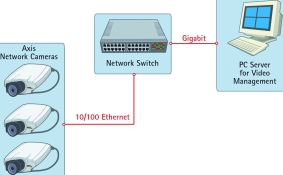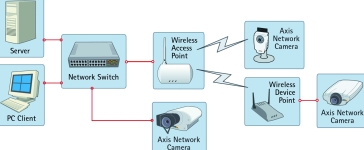
The Internet Protocol (IP) is the most common computer communication protocol used today by the Internet, e-mail and almost every newly installed network. One of the reasons for its popularity is its scalability. In other words, it works as well in very small installations as it does in very large ones and is supported by an increasingly wide range of high-performance, low-cost and industry-proven equipment and technologies. We look now at the different IP technologies in use to take full advantage of a network video system.
Ethernet
The overwhelming majority of networks today use Ethernet. Ethernet has evolved rapidly, but with generally excellent backward-compatibility allowing older equipment to work with newer systems. The common types of Ethernet are:
* 10 Mbps (10 Mbits per second) Ethernet. This standard is rarely used in production networks today and has been replaced by 100 Mb Ethernet since the late '90s. The most common topology used for 10 Mb Ethernet was called 10BASE-T; it uses four wires (two twisted pairs) on a cat-3 or cat-5 cable. A hub or switch sits in the centre and has a port for each node. The same configuration is used for Fast Ethernet and Gigabit Ethernet.
* Fast Ethernet (100 Mbps) is the most common type in computer networks today. The main standard, 100Base-T, is newer and faster than 10Base-T but in all other respects the same. 100Base-TX uses twisted pair copper cabling (cat-5), 100Base-FX uses optical fibre. Most 100 Mbit network switches support both 10 and 100 Mbit.
* Gigabit Ethernet (1000 Mbps) is the current standard endorsed for desktop computers, but is most commonly used today for backbones between network servers and network switches. 1000Base-T is subdivided into 1000Base-T over cat-5e or cat-6 copper cabling, 1000Base-SX over multimode fibre (up to 550 m), 1000Base-LX over multimode fibre (up to 550 m) or optimised for longer distances (up to 10 km) over single-mode fibre, 1000Base-LH over single-mode fibre (up to 100 km).
* 10 Gigabit Ethernet (10 000 Mbps) is the newest option for backbone enterprise networks. It uses seven different media types for LAN, WAN and MAN (metropolitan area network), currently specified by a supplementary standard, IEEE 802.3ae.

Power over Ethernet
Power over Ethernet (PoE) integrates power into a standard LAN infrastructure to supply the network device, such as an IP phone or a network camera, over the network cable. It eliminates the need for separate power outlets and enables easier application of uninterruptible power supplies (UPS) to ensure 24/7 operation. PoE is specified in IEEE 802.3af. It does not degrade the network data performance or range. PoE is automatically activated when a compatible device is attached, and blocked for legacy devices, so you can safely mix them. Up to 12.9W can be supplied to the device/camera side, making it suitable for indoor cameras. Outdoor cameras and PTZ and dome cameras normally require more than this, so may not be suited to PoE use. Some manufacturers also offer proprietary products providing suitable power for these applications, but interoperability between different brands is seldom possible. The 802.3af standard also provides support for so-called power classification, which allows for a negotiation of power consumption between the PoE unit and the devices.
Using power over Ethernet
Today, most manufacturers offer network switches with built-in PoE support. If an existing network /switch structure is in place, customers can support PoE by adding a so-called Midspan to the switch, which will add power to the network cable. Network cameras without built-in PoE can be integrated in a PoE system using an Active Splitter. Figure 2 illustrates PoE using a Midspan.

Wireless
Sometimes a non-wired solution is needed. For example, in a protected building, where there is a need to move the camera on a regular basis as in retail, or to bridge two buildings or sites. There are two major wireless categories:
* Wireless LAN (also known as WLAN), over short distances and normally indoors. Nowadays, devices from different vendors usually work well together.
* Wireless bridges to connect buildings or sites where a point-to-point data link capable of long distances and high speeds is required. Commonly used technologies are microwave and laser.
Wireless LAN standards
802.11a uses the 5 GHz band, nominally 54 Mbps, up to ~24 Mbps actual throughput, up to 30 m/100 feet in outdoor environments. Limited support.
802.11b is the most common standard, using the 2,4 GHz band, nominally 11 Mbps, up to ~5 Mbps actual throughput at up to 100 m/300 feet in outdoor environments. Almost all products today support this standard.
802.11g is relatively new, uses 2,4 GHz, nominally 54 Mbps, up to ~24 Mbps actual throughput at up to 100 m/300 feet in outdoor environments.
Figure 3 shows a typical mixed network, with a wired camera, a wireless camera, and a wired camera with a wired/wireless bridge. Wired bandwidth is always better and more stable than wireless, and should be preferred where possible.

About security in wireless networks
Without security, everyone in range can eavesdrop on the data transmissions. The most common standard today is WEP (Wired Equivalent Privacy), which adds encryption to the communication, and prevents people without the correct key to access the network. But as the key itself is not encrypted, this should be seen only as a basic level of security. A WEP-key is normally of either 40 (64) bits or 128 bits length. Newer standards significantly increase security, such as WPA (WiFi Protected Access) standard, which takes care of some shortcomings in the WEP standard, including the addition of an encrypted key.
Wireless bridges
Some solutions may also use other standards for increased performance, much longer distances or very high security. Microwave and laser links may be used. A microwave link can provide up to 1000 Mbps for distances up to 130 km. There is also the option of satellite communication, but the latency can be very long (up to several seconds), making it less suitable for remote dome control and video conferencing, and high bandwidth also becomes very costly.
For more information contact Roy Alves, SCS, 011 548 6780, [email protected]
| Tel: | +27 11 548 6780 |
| Email: | [email protected] |
| www: | www.axis.com |
| Articles: | More information and articles about Axis Communications SA |
© Technews Publishing (Pty) Ltd. | All Rights Reserved.